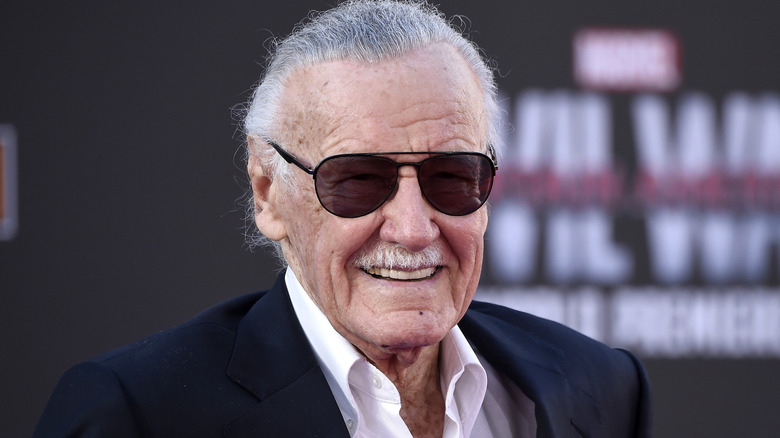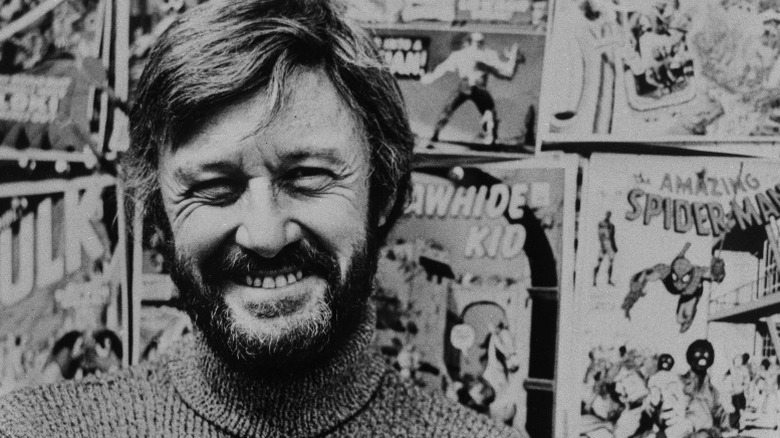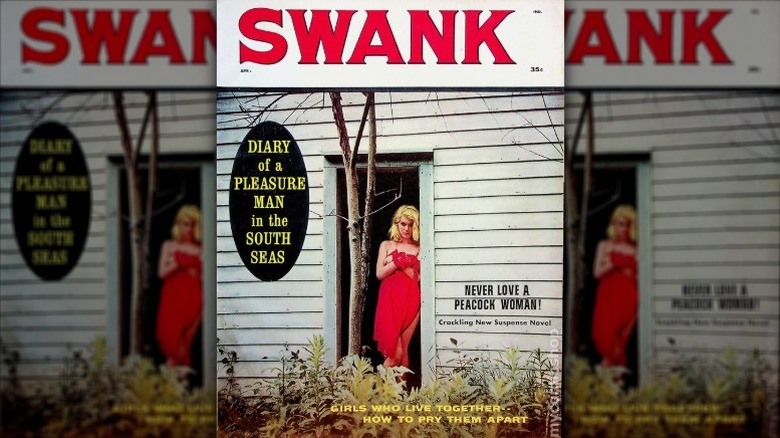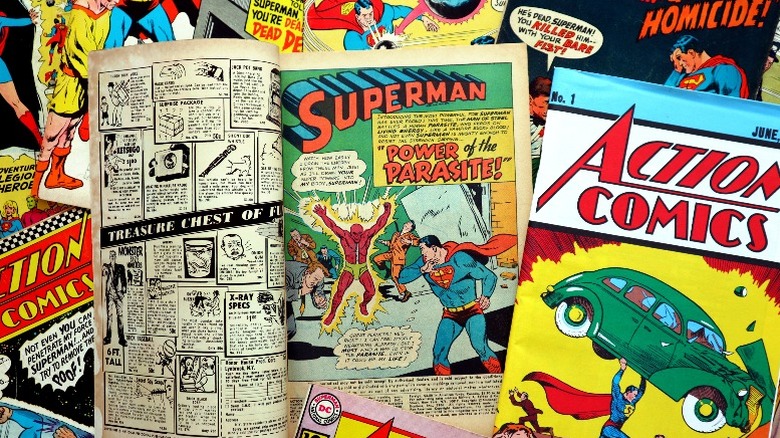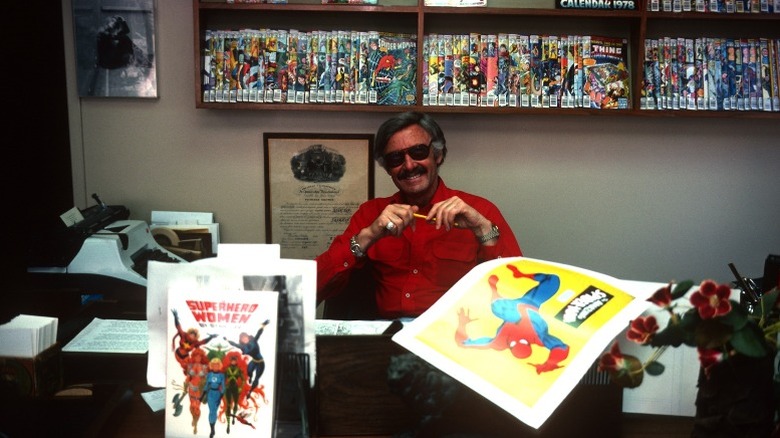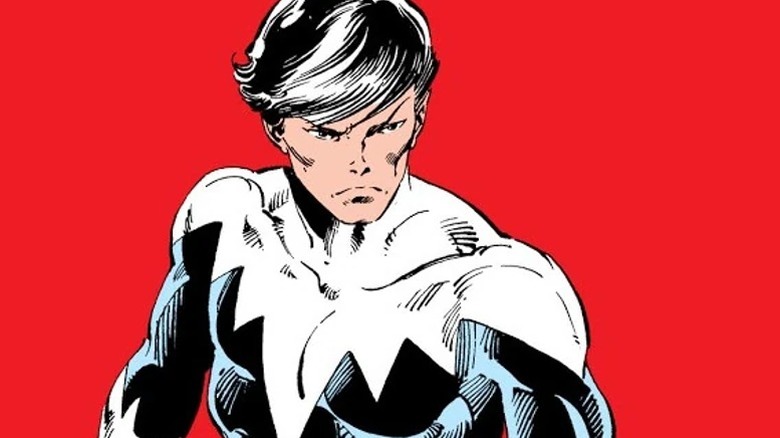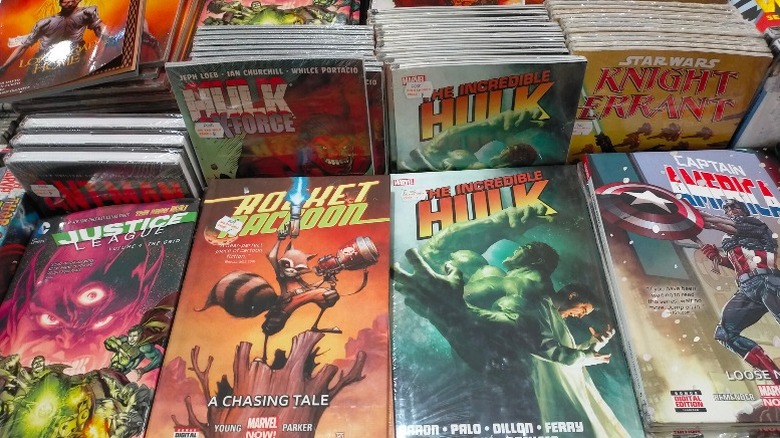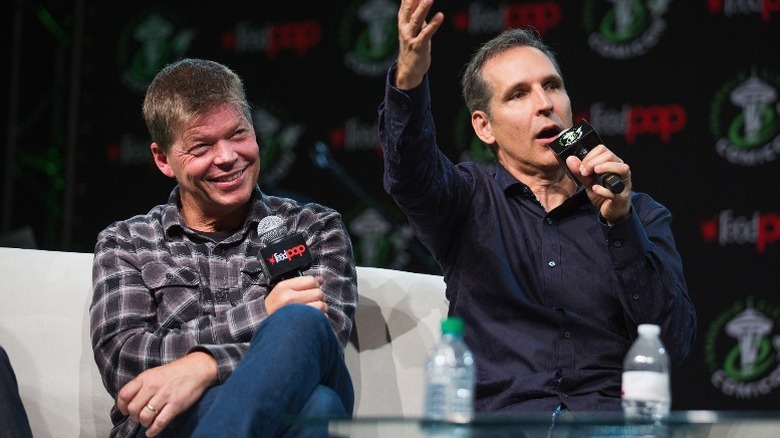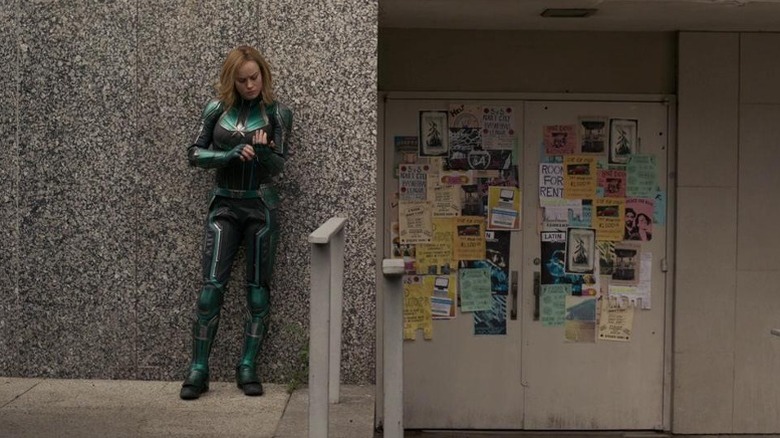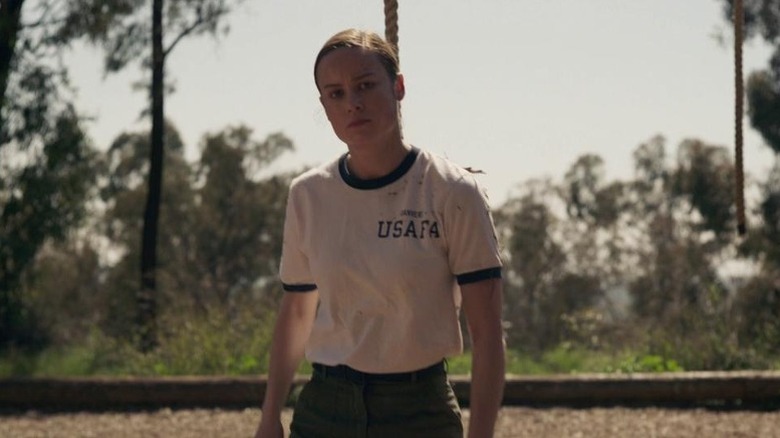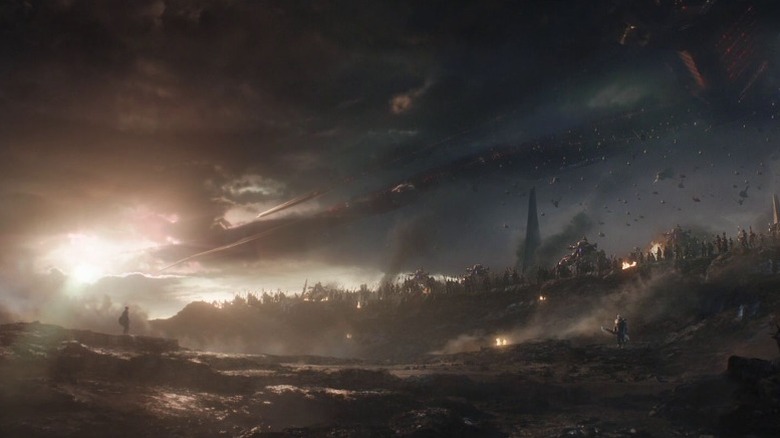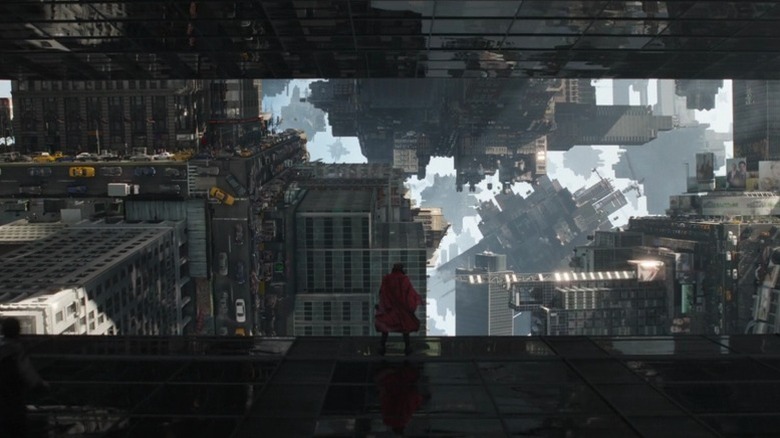Marvel's Worst Secrets Exposed
Under one name or another, Marvel Comics has existed for 85 years now — nearly as long as superhero comics themselves. The most iconic and influential of all American comic book publishers has a winding, fascinating history that has often paralleled the ups and downs of American society, culture, and economy at large. At some junctures, including as recently as two and a half decades ago, Marvel faced tumbles severe enough to threaten its very existence, yet it has always managed to turn things around and come out on top, whether by introducing barn-burning new superhero teams or reinventing itself as a 21st-century multimedia giant.
Still, there were the tumbles — some of them ugly, and not always strictly financial. Although diehards probably know most of the publisher's darker history by heart, more casual fans of the comics and the cinematic empire built upon them may be surprised to learn that there are many sordid, scandalous, and eyebrow-raising facts about Marvel's real-world lore. Here, we've compiled a few tidbits about the company, from office intrigue to poor management decisions to political and labor controversies, that evince a different side of Marvel from what we usually see.
Stan Lee was technically a nepo baby
Anyone who knows a little about Marvel Comics history knows that Stan Lee, whose movie cameos became the signature of Marvel Studios productions, was not actually the company's founder. Timely Comics, the comics magazine company that would later become Marvel, was founded by Martin Goodman in 1939, and Lee's imprint on the brand came later when he spent two decades as its creative head and oversaw its transformation into the giant we know today. But what not everybody knows is that to get his foot in the door at Timely Comics, Lee had a little help from familial ties.
Although accounts of his career beginnings have varied over the years, Lee himself wrote in his autobiography that his uncle Robbie Solomon, an employee at Marvel in 1940, suggested his nephew apply for a position there when he was 16 to 17 years old. Solomon personally introduced Lee — who went by his birth name of Stanley Lieber at the time — to editor Joe Simon. Even more importantly, however, Lee was the cousin of Jean Davis, Martin Goodman's wife. According to Simon, Goodman had Solomon ask him to put his wife's teenage cousin to work; Lee then began to work as Simon's assistant. From there on out, Lee's rise through the ranks was rapid, but having a family connection to help him get the job in the first place certainly didn't hurt.
One of the earliest Marvel publishers also ran racy magazines
Eventually, the publishing house that began as Timely Comics became Atlas Comics, a rebranded outfit that focused on quick, formulaic work following safe commercial trends. It was under Atlas Comics that the magazines of the characters who'd eventually flourish under the Marvel banner continued to be published. What few people know is that Atlas was a division of a larger publishing company — also founded by Martin Goodman — known as Magazine Management, which remained the parent company of Marvel until well into the 1960s. What even fewer people know is that, among the other kinds of publications that Magazine Management ran in the '50s and '60s, the flagship was the men's magazine division, which specialized in very different content from what occupied the pages of Marvel comic books.
The Magazine Management men's magazines, including Male, Stag, and Swank, offered a combination of features considered attractive to an audience of straight adult males. Those features included adventure stories, sports and lifestyle coverage, sexual advice columns, and of course, pin-up photographs and illustrations — with the featured models often splashed on the front cover in skimpy outfits and suggestive poses. Some of those magazines even evolved into straight-up pornographic publications in later decades, but, by that point, they no longer had any corporate associations with Marvel.
Marvel once had to rely on the distribution services of ... DC Comics
In 1956, Martin Goodman decided to stop self-distributing Atlas Comics magazines, instead striking a deal with the American News Company. As fate would have it, however, the American News Company went out of business shortly after that agreement due to a Justice Department lawsuit. As a result, Atlas Comics found itself in want of a distributor.
To dig itself out of that hole, Atlas Comics turned to the only company that would agree to distribute its titles: National Comics, the publisher that would later take up the name DC Comics — the same DC in the Marvel vs. DC rivalry. Now slotted into the portfolio of Independent News Distributors, National Comics' distribution branch, the Atlas team found itself doubly humiliated. In addition to having to rely on the distribution services of its biggest competitor, the company, now momentarily renamed Goodman Comics, was forced to accept the stifling terms imposed by Independent News. Under those terms, Atlas' monthly production was drastically reduced, going from up to about 80 titles a month to fewer than 12, according to Stan Lee. Although the arrangement with National Comics didn't last long, it was certainly one of the roughest patches in all Marvel history.
Steve Ditko and Jack Kirby both fell out with Stan Lee
Although Steve Ditko and Jack Kirby were, alongside Stan Lee, central figures in Marvel's evolution, both men eventually left Marvel under bitter circumstances — largely motivated by how strained their work relationships with Lee had become.
Kirby, widely celebrated to this day as one of the greatest comic artists of all time, left Marvel for DC Comics in 1970. In later years, he frequently made negative remarks about Lee's supposed work ethic while concentrating on the duties of Marvel editor-in-chief and scriptwriter, alleging that Lee was given to delegating scripting work to other writers and then taking credit for it, and disputing Lee's claims that he, not Kirby, was the primary mastermind behind the creation of "Fantastic Four." Following Kirby's death in 1994, his estate had legal battles with Lee that extended up until 2014.
Ditko, meanwhile, made no secret of the reasons that drove him to leave Marvel in 1966. He opened up about receiving allegedly poor treatment while working for Marvel as an artist and accused Lee of fostering an environment in which only his artistic contributions and ideas were deemed essential while everyone else's were just ancillary.
Editor-in-chief Jim Shooter allegedly banned gay characters in the '80s
Marvel films and TV shows have a spotty track record with LGBT representation, to say the least; there wasn't an openly gay superhero in the Marvel Cinematic Universe until Phastos (Brian Tyree Henry) in 2021's "Eternals." And, although the comics division has contributed many additions to the roster of superheroes that are openly LGBTQ+, it has historical issues of its own to contend with. Like many publishers, Marvel avoided featuring overly queer characters for years partly due to the overwhelming homophobia running rampant in American and worldwide society (to say nothing of the draconian whims of the Comics Code Authority). What not everyone knows is that there might actually have been a corporate mandate expressly banning such characters.
Jim Shooter, who worked as Marvel's editor-in-chief from 1978 to 1987, had a controversial tenure in many respects, but the most disquieting part of his Marvel run may be the widely reported allegation that he explicitly forbade gay characters. For instance, Jean-Paul Beaubier, a.k.a. Northstar, a member of the Alpha Flight team from the "X-Men" comics, was intended by co-creator John Byrne to be gay, but Byrne has stated that Shooter banned explicit mentions of the character's sexuality. To make matters worse, Shooter himself wrote a "Hulk" comic in 1980 that featured the first openly same-gender-attracted characters in Marvel history — in the form of two YMCA men who attempt to assault Bruce Banner in the shower. Hard to decide what was worse between that and the erasure.
Marvel Entertainment Group was nearly run into the ground after going public
Generally speaking, companies have a way of springing for hypercommercial enterprises and indulging in bloat and formula repetition after going public — something about the stock market just seems to favor the search for endless growth at any cost. Marvel was a case study. In the late '80s, the company reached its commercial apogee, with "Spider-Man" and "X-Men" issues basically printing money while various other series continued to thrive. It was at that point that, in 1989, Revlon executive Ronald Perelman bought Marvel Entertainment for over $82 million.
In 1991, Perelman took Marvel Entertainment public — a decision that fell in line with the growing comics speculation bubble, in which collectors were stacking up comics in hopes of later re-selling them at exorbitantly high values. In addition to buying Marvel, Perelman also shelled out massive amounts of money to buy trading companies. Marvel, meanwhile, turned its focus more and more aggressively toward making as much money as possible, increasing the volume of publication, betting big on crossovers, mining extra coins through variant covers, and producing more comics-adjacent merchandise than ever. Yet the quality of the comics themselves did not remain up to standard, and Marvel began to cheapen its brand and wear out its fan base through sheer saturation.
Several writers and artists defected from Marvel to start Image Comics
As if the fatigue spurred by Ronald Perelman's voracious business strategy weren't enough of a problem for Marvel fans, 1992 dealt another blow to the company's mystique: Seven of the greatest Marvel artists defected the company to start their own comics publishing company. The artists were Todd McFarlane and Erik Larsen of "Spider-Man," Rob Liefeld of "The New Mutants" and "X-Force," Jim Lee of "X-Men," Whilce Portacio of "The Punisher" and "The Uncanny X-Men," Marc Silvestri of "Wolverine," and Jim Valentino of "Guardians of the Galaxy." The company they started was none other than Image Comics, responsible for the envelope-pushing, decidedly non-family-friendly antics of "Invincible," "The Walking Dead," and numerous other hit titles.
Beginning with McFarlane, Liefeld, and Lee, who at the time were Marvel's three most valued creatives and three of the most powerful comic artists in the world, the seven men left Marvel for a new project due to a pronounced dissatisfaction with how talent was being treated at the company. Their founding of Image changed the face of the comics industry forever and left Marvel floundering even more creatively than it already was. And it happened specifically because Marvel, as it grew into an industry titan with the hottest stock in town, had begun to take the artists — i.e., the people who made the company in the first place — for granted.
Marvel had to file for bankruptcy in 1996
All booms come to an end, and, by the mid-'90s, it was clear that growing exponentially forever was not, in fact, a viable option for Marvel Entertainment Group. Nor for the comics industry as a whole, for that matter: Just as quickly as it had grown to utterly unreasonable proportions, the comics speculation bubble burst dramatically and spectacularly. All of a sudden, comics were no longer viable investments, and the market of collectors looking to resell in the future evaporated, leaving the entire industry in a massive slump. Marvel, the giant lording over it all, had the hardest fall.
In 1996, Marvel saw its shares absolutely bellyflopping and found itself over $600 million in debt. Ultimately, Ronald Perelman filed for Chapter 11 bankruptcy that year, initiating a legal scuffle for control of Marvel that ended with toy company Toy Biz, owned by Isaac Perlmutter and Avi Arad, buying Marvel in 1997.
The period leading up to and immediately following the bankruptcy was the darkest ever for Marvel, with fans and artists alike wondering if there was any light at the end of the tunnel for the iconic publisher. All it had left was a stable of characters loved around the world — but it was in such dire need of money that it licensed those at a bargain, selling the "Spider-Man" movie rights to Sony and the "X-Men" movie rights to Fox.
Former CEO Isaac Perlmutter seemingly opposed female-led superhero movies
Although the story of how Marvel recovered and rebounded from its near-death in the '90s by betting everything on the MCU is extremely impressive, the universe itself has not been without its controversies and infamies. To the many Marvel fans who espouse progressive and inclusive values, it may have been dispiriting enough to see Isaac Perlmutter, the former Marvel Entertainment CEO who oversaw the rise of the MCU between 2009 and 2015, develop a close political relationship with Donald Trump and act as an unofficial advisor to his administration. Those who'd been paying attention to Perlmutter's history, however, were probably not shocked by that development.
After all, this was the same Perlmutter who, in one of the various emails leaked following the Sony Pictures hack of 2014, appeared to frontally oppose the idea of making a female-led superhero movie. In a message to Sony exec Michael Lynton, Perlmutter listed "Electra," "Catwoman," and even 1984's "Supergirl," citing their poor financial performances as examples of something he'd discussed with Lynton on the phone — presumably, the idea that superhero flicks centered around women were bad business. While it could, with some effort, be charitably assumed that Perlmutter was suggesting a trend the MCU could buck with female-led films of its own, that would seem extremely unlikely given his political affiliations — and the fact that it took Marvel 10 years and the end of Perlmutter's tenure to finally release "Captain Marvel."
Marvel Studios has a controversial relationship with the U.S. military
Like the majority of contemporary American action blockbusters, Marvel Cinematic Universe films are frequently made in collaboration with the U.S. military. Although the U.S. Department of Defense and the Armed Forces don't officially contribute any direct funding to Marvel productions, they have repeatedly struck deals with Marvel involving the lending of real military equipment and bases in exchange for script approval. This has led to a depiction of the U.S. military in Marvel movies that some fans and critics have called out as biased, if not outright propagandistic.
The first two "Iron Man" films, the first two "Captain America" films, and "Captain Marvel" all were made under such collaboration deals with the military. In the case of "Captain Marvel," the collaboration was especially overt. The film focuses heavily on Carol Danvers' (Brie Larson) life as an Air Force pilot, and several training montages in the film were shot with a glossiness reminiscent of recruitment ads — which was compounded by the film being explicitly used in U.S. Armed Forces social media marketing, and by Larson herself, who notoriously got ripped for the role, shooting promos for the military. More recently, "WandaVision" gave a lot of screen time to FBI agent Jimmy Woo (Randall Park) — which wouldn't necessarily seem fishy if not for the fact that the show includes special thanks to the U.S. Department of Defense in its end credits.
Marvel films have been accused of establishing screen monopolies in certain countries
The controversies around MCU movies don't stop at what's in the movies themselves; the way that they are economically positioned and distributed has also attracted heavy criticism in some parts of the world. The relative financial wobbliness of the post-Phase Four MCU releases has somewhat dimmed the memory of their once-unassailability. But before that, the release of "Avengers: Endgame" was stirring controversy over Disney's practice of laying claim to as many movie screens as it can in international markets.
In Brazil and South Korea, journalists, politicians, and film industry professionals called attention to the fact that the history-making box office success of "Avengers: Endgame" might not have been entirely organic. In both countries, Disney took advantage of the humongousness of "Endgame" to occupy more than half of all theater screens — as much as 80% of all screens in Brazil's case. These were de-facto screen monopolies, resulting, of course, in local and smaller films getting crowded out.
It's a difficult practice to restrain without robust, effectively enforced regulation: Banking on the fact that films like "Endgame" are presumed to be guaranteed money-makers, Disney can persuade theater owners to give them disproportionate space in the schedule. As a result, international theatergoers who aren't fond of superhero flicks may find themselves bereft of anything to watch in their local theaters whenever a new MCU movie is out.
The studio's treatment of VFX artists remains a hot-button issue
Due to the way that Hollywood is currently structured, VFX artists are among the film workers subjected to the harshest labor conditions. Most VFX work is done by contracting: Firms bid on a certain number of shots, and whichever company can offer the quickest turnaround time for the lowest rate will have the upper hand. In practice, this results in VFX artists being saddled with unreasonable, unrealistic deadlines and limited resources, which in turn leads to long, stressful hours. With that in mind, Marvel has a reputation in the VFX industry for being a particularly overbearing client.
There have been reports of Marvel imposing conditions on VFX contracts that forced workers into multiple months of 60-to-80-hour work weeks. The studio is known for demanding near-complete visualizations very early on, and then requesting numerous changes even to finished and approved effects — sometimes up to the final weeks of post-production. After years of chatter among industry workers about how Marvel projects should be avoided if possible — and, considering the hold they have on the VFX industry, it's not always possible — the VFX workers at Marvel Studios moved to unionize, with a supermajority manifesting interest in joining the International Alliance of Theatrical Stage Employees (IATSE). Although the in-house Marvel VFX workers are only a fraction of the hundreds of artists who work on the visual effects for MCU productions, it was still a crucial and symbolic step for the section of the Hollywood workforce that's arguably in direst need of sturdier protections.
